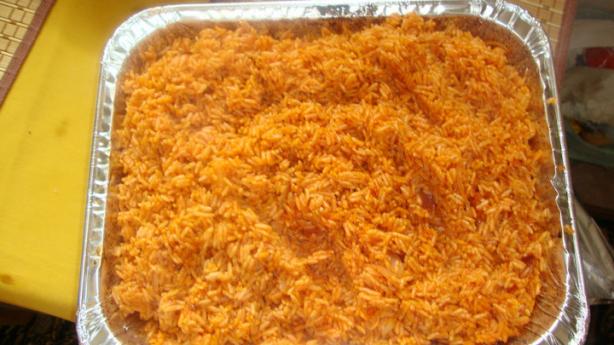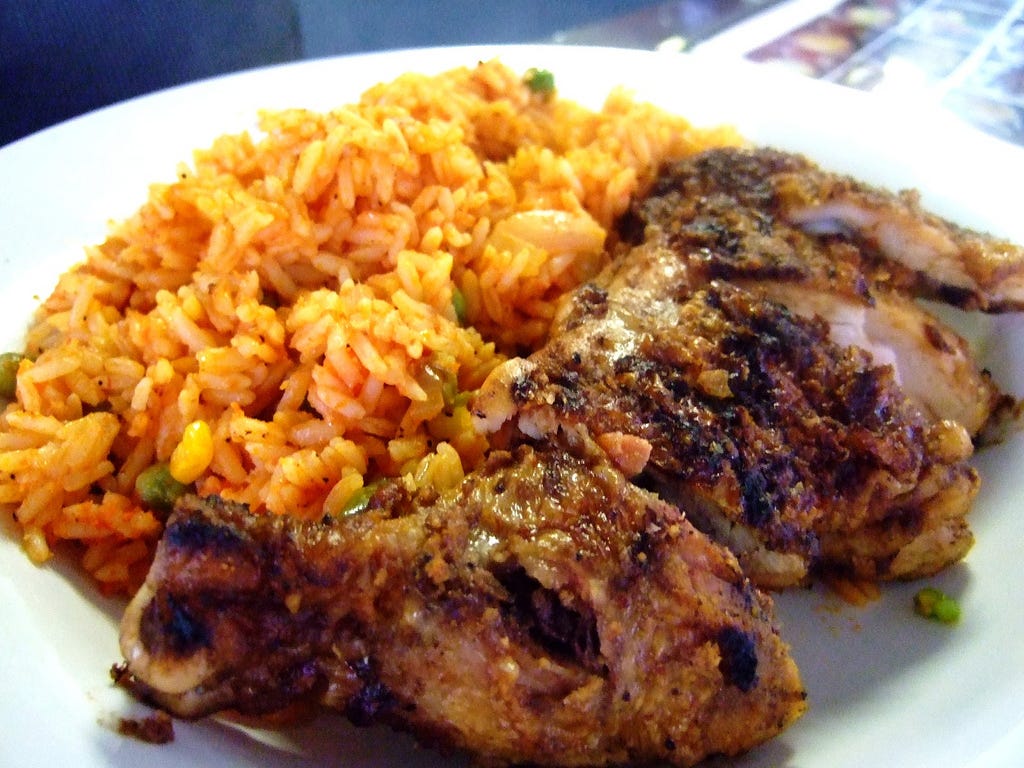Jollof rice



Jollof rice was originally a native of
the Wollof people of the SeneGambian region of West Africa before it became a
celebrate delicacy all over.
The News office Desk of the
E.N.M.Paedia Express Multimedia of Lagos,Nigeria serves you insights of this
premium consumables in conjunction with google search and wikipaedia
Geographical range and
origin[edit]
Jollof
rice is one of the most common dishes in Western Africa, consumed throughout the
regions of Nigeria, Senegal, Ghana, Sierra Leone, Gambia, Togo, Liberia, Mali, Ivory Coast and Southern Cameroons.
In Cameroon it is a common favorite at ceremonies such as weddings, graduations
and birthdays and is sometimes cooked with "ndole", a local
vegetable. There are several regional variations in name and ingredients.[1] In
Mali it is called zaamè in Bamanankan, and is a typical Sunday lunchtime
favorite in urban, middle-class families. The name Jollof derives from the name of the Wolof people,[6] though
in Senegal and Gambia the dish is referred to in Wolof as ceebu jën or benachin.
In French-speaking areas, it is called riz
au gras. Despite the variations, the dish is "mutually
intelligible" across the region, and has spread along with the diaspora to
become the best known African dish outside the continent.[2][5].
Based on
its name, the origins of jollof rice can be traced to the Senegambian region that was ruled by the Jolof Empire. Food and agriculture historian
James C. McCann considers this claim plausible given the popularity of rice in
the upper Niger valley, but considers it unlikely
that the dish could have spread from Senegal to its current range since such a
diffusion is not seen in "linguistic, historical or political
patterns". Instead he proposes that the dish spread with the Mali empire, especially the Djula tradespeople who dispersed widely to the regional
commercial and urban centers, taking with them economic arts of
"blacksmithing, small-scale marketing, and rice agronomy" as well as
the religion of Islam.[2] Marc
Dufumier, Emeritus Professor of Agronomy proposes a more recent origin for the
dish, which may only have appeared as a consequence of the colonial promotion
of intensive peanut cropping in central Senegal for the French oil industry,
and where commensurate reduction in the planted area of traditional millet and
sorghum staples was compensated by forced imports of broken rice from Indochina[7]. It may then have spread throughout the
region through the historical commercial, cultural and religious channels
linking Senegal with Ghana, Nigeria and beyond, many of which continue to
thrive today, such as the Tijāniyyah Sufi
brotherhood bringing thousands of West African pilgrims to Senegal annually.
Ingredients[
Fried rice, jollof rice and salad, served with grilled
chicken
The dish
consists of rice, tomatoes and tomato paste, palm oil, onions, salt, spices (such as nutmeg, ginger, and cumin)
and chili peppers (such as Scotch bonnet); optional ingredients can be
added such as vegetables, meats, or fish.[8] Due
to the tomato paste and typically used red palm oil, the dish is mainly red in
colour.[5] The
recipe differs from one region to another.
Nutrition[edit]
The main
ingredients of jollof rice are rice and tomatoes; neither has any saturated fat or cholesterol.[9] The
addition of palm oil does add saturated fat. Jollof is primarily carbohydrates, as it is a rice dish. Since
jollof is often served with chicken, beef, eggs and/or turkey, it is
complemented by the protein from those accompanying dishes. Fish is sometimes
used as an accompaniment, and can provide the dish with omega-3 fatty acids,
as well as protein.
Presentation[edit]
On the
event of special occasions such as birthdays, weddings or baby showers, the
dish can be presented and served made into shapes, overall a more formal
presentation of the dish. As an option, fried plantain can also be placed on
top, or beside the jollof rice, and then various meats are added around the
rest of the dish.
Nigerian and Ghanaian debate[edit]
There are
multiple regions in Africa who
debate over the geographical origins of jollof rice. However, one of the most
vigorous jollof rivalries has been between Nigerians and Ghanaians. The main
argument in this debate is currently centered on which country's version tastes
better. The reason for the debate is due to the huge popularity of jollof, in
regards to West African cuisine. Both Nigeria and Ghana have shown consistent competitiveness
over the debate as to who can serve the dish the best.[10] The
debate has gone so far as to even having organized contest shows like the
Jollof Festival in Washington, DC, [11] in
order for famous critics from all over the world to taste, examine the
differences, and give their overall judgments on either forms of the dish.
Recently, social media has also become a popular tool for people to share
pictures, and opinions over who serves the dish the best.
Nigerian jollof[edit]
Although
considerable variation exists, the basic profile for Nigerian jollof rice
includes long grain parboiled rice, tomatoes and tomato paste, pepper,
vegetable oil, onions and stock cubes. Most of the ingredients are cooked in
one pot, of which a fried tomato and pepper puree characteristically forms the
base. Rice is then added and left to cook in the liquid. The dish is then
served with the protein of choice and very often with fried plantains, moi moi, steamed vegetables, coleslaw, salad,
etc.
In the
riverine areas of Nigeria where seafood is the main source of protein, seafood
often takes the place of chicken or meat as the protein of choice and there are
variations of the classic jollof rice; including coconut jollof rice, fisherman
jollof rice (made with prawns, periwinkles, crayfish), mixed vegetables jollof
rice, and rice and beans. More economically friendly versions of jollof rice
are popularly referred to among Nigerians as “concoction rice,” the preparation
of which can involve as little as rice and pepper.
Ghanaian jollof[edit]
Ghanaian
jollof rice is made of vegetable oil, onion, bell pepper, cloves of pressed garlic, chillies, tomato paste, beef or goat meat or
chicken (some times alternated with mixed vegetables), jasmine or basmati rice and black pepper.[12] The
method of cooking jollof begins with first preparing the beef or chicken by
seasoning and frying it until it is well-cooked[12] The
rest of the ingredients are then fried all together, starting from onions,
tomatoes and spices in that order. After all the ingredients have been fried,
rice is then added and cooked until the meal is prepared. Ghanaian jollof is
typically served with side dishes of beef, chicken, well-seasoned fried fish,
or mixed vegetables.
Jollof in
Ghana is also served alongside shito,
a popular type of pepper which originates from Ghana, and salad during parties
and other ceremonies
No comments:
Post a Comment